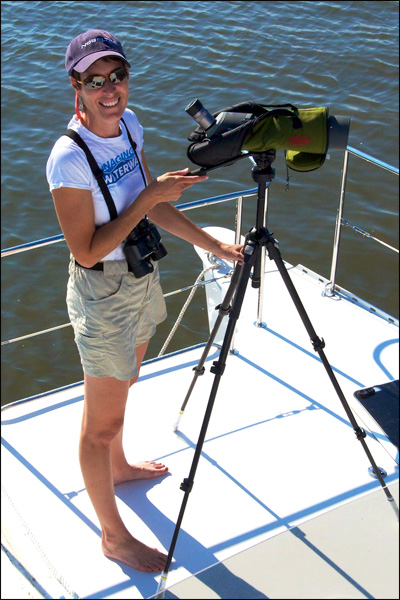 |
| Diana Doyle spotting wildlife in a quiet South Carolina saltmarsh anchorage. |
A year ago, I wrote about “Birding Aboard” for Women and Cruising‘s series, Take Your Passion Cruising.
It turned out I was not alone in my passion for observing and enjoying birds while cruising.
Thanks to the phenomenal network of Women and Cruising, I connected to several other dedicated “birders-aboard,” including
- Beth Leonard
on s/v Hawk, - Brenda Free
on s/v Willow, - Devi Sharp
on s/v Arctic Tern, - Jeanne Socrates
on s/v Nereida, - Katharine Lowrie
on s/v Lista Light, - Wendy Clarke
on s/v Osprey, - Yvonne Katchor on s/v Australia 31,
- and Dorothy Wadlow on s/v Joyant.
Together we organized the first worldwide “SeaBC” SeaBird Count, where cruisers tally and submit their ocean and coastal bird sightings to eBird‘s online database. These sightings become a resource for scientists and provide much-needed data on seabird abundance and distribution.
Participation spanned over 100 degrees of latitude — from the Gulf of Maine at North 48º to South 58º on Antarctica’s Weddell Sea. But most counts were from more temperate latitudes, such as the islands off Africa, Chile’s Golfo de Penas, and the Caribbean.
And this year’s inaugural SeaBC was promoted by three long-distance cruising rallies: the Atlantic Rally for Cruisers, Baja Ha-Ha, and Caribbean 1500.
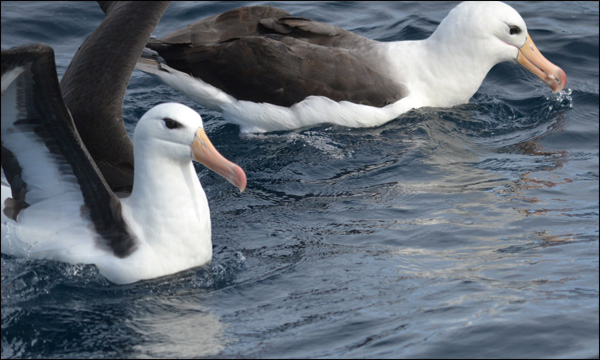 |
| Two Black-browed Albatross that landed by S/V LISTA LIGHT on passage from Falklands to Uruguay (Photo by Katharine Lowrie) |
But this post is not only about the SeaBC event, it’s about how this event illustrates the passion and commitment many women aboard have for the natural world.
Women aboard boats value nature. Of course men love nature also. But I’d venture that many women who thrive long-term aboard a cruising boat really love nature. The cruising lifestyle connects them with nature in a way that a climate-controlled condominium never can. And they love their boat, in part, because it’s their magic carpet to an endless supply of captivating new natural observations with each change of latitude.
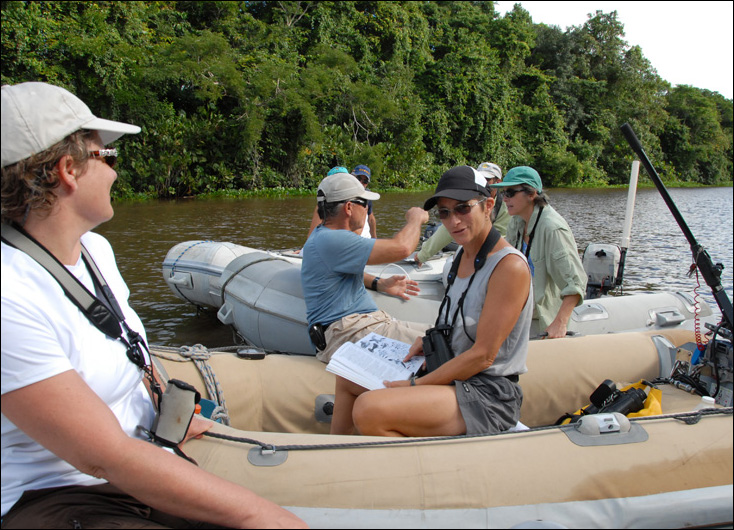 |
| Devi Sharp shares her knowledge during a cruiser raft-up in Venezuela. (Photo by Charles Shipley) |
Women also embrace volunteerism. We can’t change generations of cultural imprinting! And the SeaBC taps into our enthusiasm for contributing in a way that is compatible with the cruising lifestyle. As volunteerism adapts to technology, citizen science takes environmental projects to the Internet. You may sometimes feel like a floating island, but you can still participate in your areas of interest by collecting and photographing geo-referenced data and uploading it to citizen science projects.
So the important role of women in launching this inaugural event isn’t just a coincidence.
Thank you Women and Cruising!
How You Can Help…
- Join Facebook.com/Birding.Aboard, where you can share sightings, get ID help, and see news about next year’s SeaBC.
- On your next coastal or offshore passage, take digital photos of seabirds and report your sightings to www.eBird.org.
- If you’re not a birdwatcher, no problem—you can make an important contribution by reporting hourly stretches of “zero sightings.” Scientists and conservationists need to know where the birds are—and are not.
- Volunteer to print and post a color PDF flyer at marinas you visit.
The SeaBC Sea Bird Count project needs help getting posters disseminated to marinas and yacht clubs worldwide. If every Women and Cruising reader would take a few minutes to print a downloadable poster, then post it at their next marina port-of-call, imagine the reach! The one-page poster, printable on standard-size paper, is available for download here.- Know a second language? We need help translating our one-page tally sheet to French, Spanish, German, …
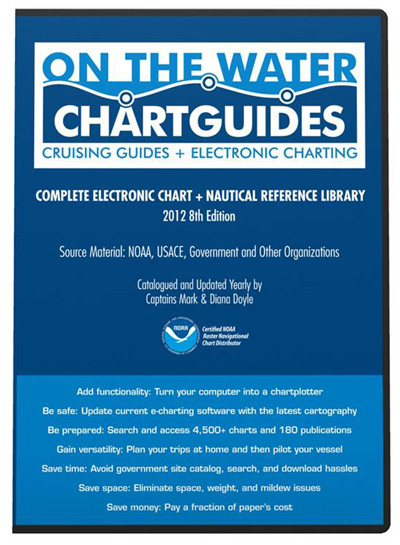
About Diana Doyle
Diana Doyle and her husband Mark write the cruising guide and electronic charting series, Managing the Waterway—now known as On the Water ChartGuides to reflect their full-time surveying and cruising status.
Diana holds a 50-ton USCG Master’s License and is the “Tools of the Trade” Department Editor for American Birding Association‘s Birding magazine (www.aba.org).
Read also on this website
- Take your passion cruising:
Diana Doyle enjoys “birding aboard” as she writes cruising guides - In the Women & Cruising Amazon bookstore:
Nature guides that Women & Cruising contributors carry aboard their boats.
More information (external links)
- Facebook.com/Birding.Aboard:
Share sightings with other birders aboard long-distance boats. - The eBird website: On-line database of bird observations.
- American Birding Association website
- www.onthewaterchartguides.com
Do you agree with Diana that many women who thrive long-term aboard a cruising boat really love nature? How important is that aspect of cruising for you?
Email kathy@forcruisers.com or leave a comment below.

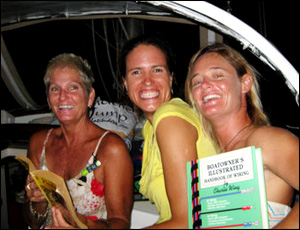
We’ve been cruising for 30 years on two different boats. We’ve been on a circumnavigation now for 10 years straight.
I’m very interested in being more involved in the global community. While I love visiting the islands and countries, I want to also impact these places and peoples in a positive way. We always leave a clean wake and make friends, but since we travel alone most of the time we are not very connected to any projects and that is what I feel is missing right now in my travels.
I hope to learn of ways I can contribute as we sail along. We are now in Indonesia and heading towards the Pacific (east about). We are so fluid with our plans we have no idea where we will head to once we leave Indonesia up near Sulawesi or Iryan Jaya. Maybe just where the wind blows….
That is the cool thing about citizen science in the Internet age. You can be fairly isolated—in fact, the more off the beaten path you are the more you are contributing new knowledge! But you are one piece in a community of eyes and ears out there. There are citizen science projects for sea turtles, whales, reporting ocean garbage items and quantities, even photographing shorelines to document erosion!